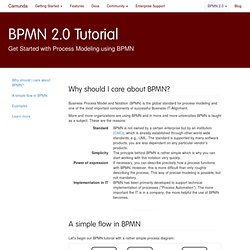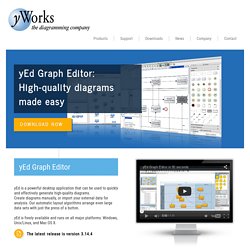

BIM Framework: Conceptual Model. BPMN Modeling Reference - All BPMN 2.0 Symbols explained. BPMN Online Training We are currently working on a BPMN Online Training.

If you are interested in this, please join the Camunda BPM Network to be notified once it is available. Join the Network now Coverage in process engine: If you are interested which elements can be automated using the camunda BPMN 2.0 process engine check out our BPMN 2.0 Coverage. Events We already described how to use lanes to assign responsibility for tasks or subprocesses to different task managers. In the diagram below, the "conductor" arranges for Falko to process task 2 as soon as Robert completes task 1.
Do you think this is unrealistic? But to coordinate cooperation with BPMN requires explicit modeling. That seems complicated - and you don't have to choose this method for practical modeling. Have you heard of service orchestration in connection with Service Oriented Architecture (SOA)? You can eliminate pools and work just with lanes, modeling the message exchange as normal tasks as shown before. Task Markers. Introduction au BPMN 2.0 - Le diagramme de collaboration. Introduction au BPMN 2.0 - Les passerelles. BPMN Tutorial - BPMN 2.0 Tutorial for Beginners - Learn BPMN. When naming tasks, we try to adhere to the object-orientated design principle of using the [verb] + [object] pattern.

We would say "acquire groceries," for example, not "first take care of shopping for groceries. " Events refer to something that has already happened regardless of the process (if they are catching events) or as a result of the process (if they are throwing events). For this reason, we use the [object] and make the [verb] passive in voice, so we write "hunger noticed. " BPMN does not require you to model start and end events for a process - you can leave them out - but if you model a start event, you must model an end event for each path.
The same is true for end events, which require start events. yEd - Graph Editor. “ As a software developer, I used to use Graphviz for my code comprehension needs.

While its compact format has its advantages, it was just too much effort to input data - particularly relationships. I wanted to be able to create relationships by dragging my mouse from one node to another. This is exactly how yEd works.You don't have to sacrifice the longevity of plain-text that Graphviz files offer. yEd works entirely on the XML-based GraphML format. You get the same benefits of cross-platform support and exporting to SVG, PNG, PDF etc. as with Graphviz. But yEd is that it is written in Java yet has a 100% native look and feel (so on Mac, you can zoom in and out with 2 finger scrolling).The best feature for me is its ability to group nodes and collapse/expand them. Software for use. In the quest for quality, software developers have long focused on improving the internal architecture of their products.

Larry L. Constantine--who originally created structured design to effect such improvement--now joins with well-known consultant Lucy A. D. Lockwood to turn the focus of software development to the external architecture. In this book, they present the models and methods of a revolutionary approach to software that will help programmers deliver more usable software--software that will enable users to accomplish their tasks with greater ease and efficiency.Recognizing usability as the key to successful software, Constantine and Lockwood provide concrete tools and techniques that programmers can employ to meet that end.
10 règles pour bien modéliser vos processus. La modélisation des processus s'est répandue au cours des dernières années. Elle est un exercice délicat, surtout pour des personnes peu préparées. Cette chronique propose 10 règles pratiques et éprouvées pour produire des modèles utiles, et les réaliser rapidement. L’intérêt de la modélisation des processus n’est plus à démontrer. Du côté des informaticiens, de nombreuses démarches de conception, d’urbanisation, d’»architecture d’entreprise» se fondent sur la modélisation des processus ; ces méthodes commencent à se diffuser du côté des utilisateurs et à attirer l’attention des décideurs. En parallèle, de nombreuses entreprises refondent en permanence leurs processus pour les optimiser et les adapter aux évolutions de leur métier.
Bien modéliser n’est pas un problème d’outillage, mais de méthode : la véritable difficulté est d’appliquer des règles simples, pour aboutir à un modèle qui soit à la fois fidèle et utile. Comparison of Business Process Modeling Notation tools. Modélisation de processus. Un article de Wikipédia, l'encyclopédie libre.

La modélisation de processus consiste à structurer et à représenter visuellement les activités de l'entreprise. Les modèles ainsi créés conduisent généralement à la création de logigrammes. Cette discipline utilise parfois l'acronyme BPM en référence au « Modélisation de procédure d'entreprise », mais cet usage tend à disparaître, car il peut être confondu avec le « Business Process Management (en) », dont la modélisation est une des activités. La distinction fondamentale entre ces deux notions de BPM réside dans le fait que pour la seconde, on s'intéresse à donner à l'entreprise les moyens de piloter et de maîtriser ses processus-métiers, tandis que la première ne consiste qu'à les modéliser (toujours avec un objectif venant de l'extérieur : optimisation de chaîne de production, expression de besoins fonctionnels pour un développement logiciel, ré-organisation suite à un rapprochement entre deux filiales d'une entreprise, par exemple). BPMN to UML.
Comparison of Business Process Modeling Notation tools.